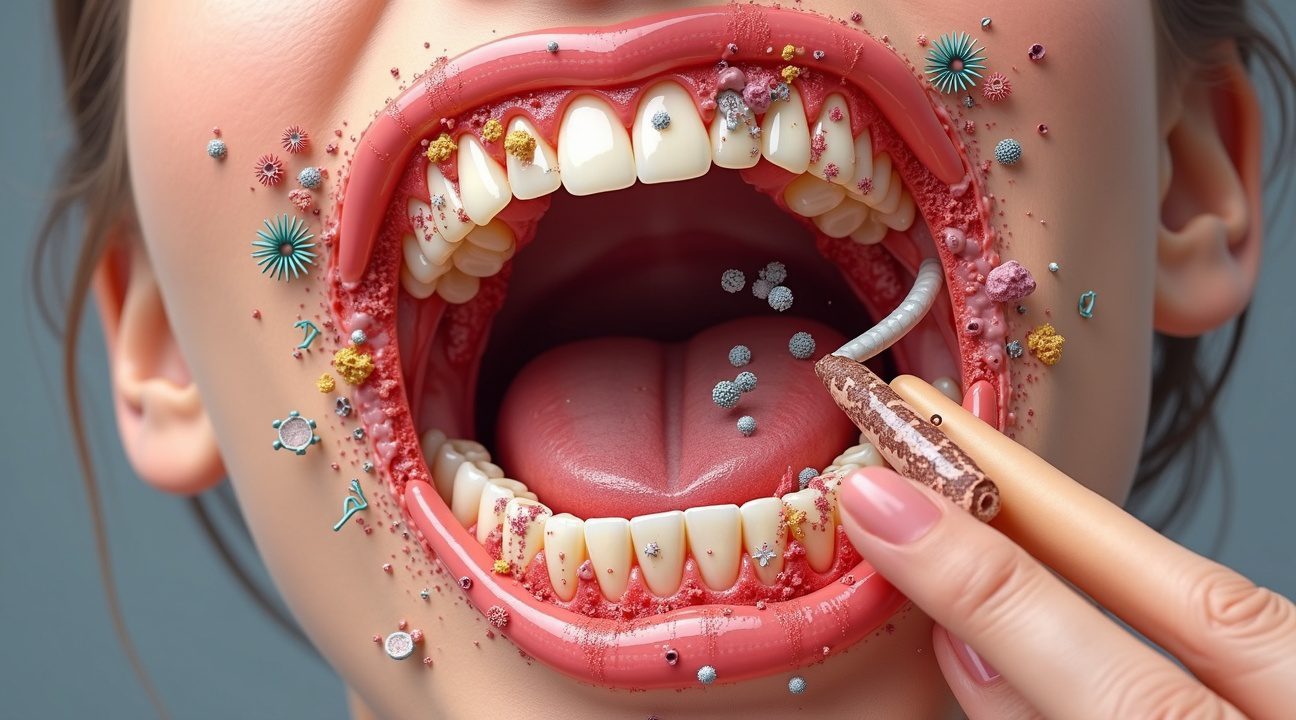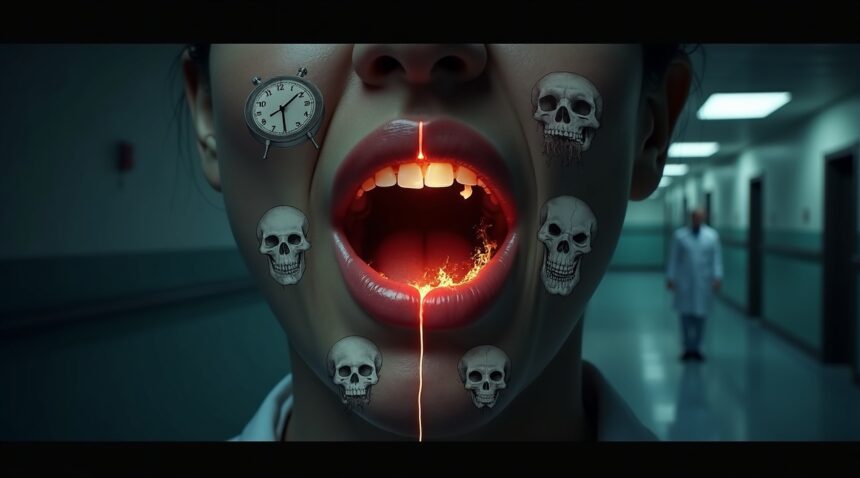Recent scientific research has revealed that certain microorganisms and lifestyle factors commonly found in the oral cavity can dramatically increase the risk of developing oral cancer, one of the deadliest forms of the disease.
Key Takeaways
- Oral cancer claims one life every hour in America, with only 57% of patients surviving five years after diagnosis, making it deadlier than cervical cancer, Hodgkin’s lymphoma, and testicular cancer combined.
- HPV16 infections and harmful bacterial communities in the mouth create inflammatory environments that damage cellular DNA and promote cancerous changes in oral tissues.
- Cancer location within the mouth significantly affects survival rates, with lip cancer showing 95% survival when caught early, while oropharynx cancers have much lower survival rates across all stages.
- Oral cancer survivors face an 85% increased risk of developing secondary cancers and significantly higher rates of cardiovascular disease, infections, and digestive complications compared to the general population.
- Despite medical advances, oral cancer remains persistently lethal with survival rates that have improved only modestly, largely due to late-stage diagnosis and the aggressive nature of the disease.
Further Reading
To learn more about the link between oral health and cancer, you can visit reputable sources such as the American Cancer Society’s page on oral cancer.
One Person Dies Every Hour from This Cancer You’ve Never Heard Of
Oral cancer silently claims one life every hour in America, yet most people remain unaware of this devastating disease. I find it alarming that close to 53,000 Americans receive an oral or oropharyngeal cancer diagnosis annually, with approximately 9,750 succumbing to the disease each year. These statistics paint a sobering picture of a cancer that flies under the radar despite its deadly nature.
How Oral Cancer Compares to Other Cancers
The mortality statistics surrounding oral cancer reveal a shocking truth about its aggressive nature. This deadly cancer actually kills more people than several better-known cancers that receive significantly more public attention and research funding. The death rate for oral cancer surpasses that of cervical cancer, Hodgkin’s lymphoma, laryngeal cancer, and testicular cancer combined.
What makes these numbers particularly striking is how little awareness exists around oral cancer compared to these other diseases. While breast cancer awareness campaigns fill October with pink ribbons and cervical cancer prevention gets regular medical attention, oral cancer remains largely invisible in public health discussions. This lack of awareness contributes directly to late-stage diagnoses and poor outcomes.
The Grim Reality of Survival Rates
The survival statistics for oral cancer tell an even more troubling story. Only 57% of patients diagnosed with oral and oropharyngeal cancers survive five years after their initial diagnosis. This five-year relative survival rate places oral cancer among the more lethal forms of the disease, particularly when compared to cancers that receive more media attention and research investment.
Perhaps most devastating is what happens in that crucial first year after diagnosis. Oral cavity and pharynx cancers account for 56.95% of cancer-related deaths within the first twelve months following diagnosis among oral cancer patients. This statistic underscores the aggressive nature of these cancers and highlights why early detection becomes absolutely critical for patient outcomes.
The rapid progression from diagnosis to death in many oral cancer cases stems from several factors:
- Many patients don’t recognize early symptoms or dismiss them as minor oral health issues.
- The location of these cancers often makes them difficult to detect during routine medical examinations unless healthcare providers specifically look for them.
- By the time symptoms become severe enough to prompt medical attention, the cancer has often already reached advanced stages.
Understanding these mortality rates becomes especially important when considering risk factors and prevention strategies. Unlike some cancers that develop seemingly at random, oral cancer often has identifiable causes and risk factors that people can address. Tobacco use, excessive alcohol consumption, and certain viral infections significantly increase someone’s chances of developing oral cancer.
The human papillomavirus (HPV), particularly strains 16 and 18, has emerged as a significant risk factor for oropharyngeal cancers. This connection has led to increased awareness about preventing viral infections and their potential long-term consequences. Some researchers have even explored whether treatments for other conditions might show promise in cancer prevention, similar to how certain medications have shown unexpected benefits across different health conditions.
These statistics also raise important questions about healthcare resource allocation and public health priorities. When a cancer kills one person every hour and has such poor survival rates, it deserves greater attention from both the medical community and public health officials. Early detection programs, increased awareness campaigns, and better training for healthcare providers to recognize early signs could dramatically improve outcomes.
The reality is that oral cancer doesn’t have to be this deadly. Many cases could be caught earlier with proper screening and awareness, potentially saving thousands of lives each year. However, until this cancer receives the attention it deserves based on its mortality rate, too many people will continue to lose their lives to a disease they never knew threatened them.

The Hidden Threats Living in Your Mouth Right Now
The mouth harbors millions of microorganisms that most people never consider as potential threats to their health. Recent scientific discoveries reveal that these microscopic inhabitants, along with certain lifestyle factors, can dramatically increase the risk of developing one of the deadliest forms of cancer.
Viral Infections That Transform Healthy Cells
Human papillomavirus, particularly HPV16, stands as one of the most dangerous residents in the oral cavity. This persistent viral infection doesn’t just cause temporary discomfort—it fundamentally alters cellular behavior in ways that can lead to oropharyngeal cancers. The virus integrates into healthy cell DNA, disrupting normal growth patterns and creating conditions ripe for malignant transformation. What makes HPV16 especially concerning is how it changes survival outcomes for patients who develop these cancers, creating different treatment challenges compared to cancers caused by other factors.
The oral microbiome extends far beyond just HPV, encompassing a complex ecosystem of bacteria, fungi, and viruses that collectively influence cancer risk. Scientists have identified specific bacterial communities that appear to promote carcinogenic changes within oral tissues. These harmful microorganisms create inflammatory environments and produce toxic metabolites that damage cellular structures over time. The balance between beneficial and harmful microbes in the mouth can tip in dangerous directions when certain conditions persist.
Chemical assaults from tobacco products and alcohol represent another major category of threats living within the oral environment. These substances don’t just pass through the mouth—they linger, creating chronic exposure scenarios that directly damage cellular DNA in oral tissues.
- Tobacco introduces over 70 known carcinogens that accumulate in saliva and soft tissues.
- Alcohol acts as a solvent that enhances the penetration of these harmful chemicals into cells.
The combination of both substances creates a particularly toxic environment that multiplies cancer risk exponentially.
Poor oral hygiene allows dangerous bacterial populations to flourish unchecked, creating chronic inflammatory conditions that stress cellular repair mechanisms. When harmful bacteria accumulate along the gum line and between teeth, they produce toxins that trigger persistent immune responses. This constant state of inflammation exhausts the body’s natural defense systems and creates an environment where cellular mutations are more likely to occur and persist.
Pre-existing oral conditions serve as warning signs that cancerous changes may already be underway. Leukoplakia, those white or gray patches that appear on the tongue, gums, or inside of the cheeks, represents cellular changes that can progress to malignancy. Persistent ulcers that don’t heal within two weeks signal that normal cellular repair processes aren’t functioning properly. These conditions indicate that the oral environment has already shifted in ways that favor abnormal cell growth.
Understanding prevention strategies becomes crucial when considering how easily these threats can establish themselves in the mouth.
- Regular dental cleanings remove bacterial biofilms before they can cause significant damage.
- HPV vaccinations can prevent the most dangerous viral infections from taking hold.
- Limiting alcohol consumption and eliminating tobacco use dramatically reduces chemical exposure that leads to DNA damage.
The interconnected nature of these threats makes them particularly dangerous. HPV infections can make tissues more susceptible to damage from tobacco and alcohol, while poor oral hygiene creates conditions that allow all these harmful factors to persist longer in the mouth. Recognition of these hidden dangers empowers individuals to take proactive steps that can significantly reduce their risk of developing oral cancers that claim thousands of lives each year.

Why Your Cancer Location Determines Your Fate
I can’t stress enough how dramatically cancer location affects survival outcomes. The specific area where oral cancer develops creates vastly different prognoses, and understanding these differences helps patients and families prepare for what lies ahead.
Stage Makes All the Difference
The stage of cancer at diagnosis serves as the most critical factor in determining survival rates. Local stage cancers that remain confined to their original site offer the best outcomes, with a remarkable 88.4% five-year relative survival rate according to the SEER database. However, this optimism fades quickly when cancer spreads beyond its initial location.
Regional spread reduces survival chances significantly, while distant metastasis creates the most challenging scenarios. Once cancer travels to distant sites throughout the body, the five-year survival rate plummets to just 36.9%. This dramatic drop illustrates why early detection becomes so crucial in oral cancer cases.
Location-Specific Survival Patterns
Different areas of the mouth present varying survival challenges, even when caught at similar stages. Lip cancer patients enjoy some of the most favorable outcomes among oral cancers. Localized lip cancer boasts an impressive 95% five-year survival rate, though this drops to 62% when the cancer spreads regionally and further declines to 46% with distant metastasis.
Tongue cancer presents a more complex picture, with localized cases achieving an 88% survival rate. The overall survival rate for all stages of tongue cancer combined reaches 71%, reflecting the varying stages at which patients receive their diagnosis. Prevention strategies become particularly important given these statistics.
Floor of mouth cancers show more modest survival rates compared to lip and tongue cancers. Localized cases achieve a 72% five-year survival rate, while the combined survival rate across all stages drops to 52%. This location often presents diagnostic challenges that can delay treatment initiation.
Oropharynx cancers, which affect the back portion of the mouth and throat area, demonstrate relatively stable survival rates across different presentations. Localized cases show a 62% five-year survival rate, with the combined rate for all stages reaching 57%. The relatively small difference between localized and overall survival rates suggests that oropharynx cancers often present at advanced stages.
These survival variations stem from several factors beyond just location:
- Blood supply and lymphatic drainage: Areas with rich vascular systems allow cancer cells more opportunities for early spread.
- Tissue barrier thickness: Thinner tissues allow for faster invasion into deeper layers.
- Anatomical accessibility: Easily visible locations like the lips lead to earlier detection and treatment.
Treatment complexity varies by location as well. Surgeons face different challenges when removing tumors from various oral sites, and some locations require more extensive reconstruction afterward. The proximity to critical structures like major blood vessels, nerves, and airways can complicate surgical approaches and affect treatment outcomes.
Understanding these location-based differences helps patients make informed decisions about treatment options and lifestyle modifications. Research continues advancing treatment approaches for different oral cancer types, offering hope for improved outcomes across all locations.
Regular dental examinations become even more critical when considering these survival statistics. Early detection remains the most powerful tool for improving outcomes, regardless of cancer location. Patients who understand their specific risk factors and maintain vigilant oral health monitoring give themselves the best chance for favorable outcomes should cancer develop.
The Deadly Domino Effect That Follows Oral Cancer
Oral cancer doesn’t simply disappear after initial treatment. Survivors face a stark reality that extends far beyond their original diagnosis. Studies reveal a shocking 85% excess risk for developing another cancer compared to people who never had oral cancer. This devastating cascade creates a lifelong battle that affects multiple body systems.
Why Second Cancers Strike Oral Cancer Survivors
The reasons behind this increased cancer risk stem from several interconnected factors:
- Genetic mutations associated with the initial oral cancer often persist, leaving patients vulnerable to further malignancies.
- Environmental exposures such as tobacco and alcohol use continue to pose risks, especially if lifestyle changes are not made.
- Radiation therapy used to treat oral cancer can induce long-term DNA damage, leading to new cancerous changes years later.
Continued habits like smoking and heavy drinking further amplify these dangers, making proactive health management essential.
Where the Cancer Spreads and Why It’s So Lethal
Second primary cancers often appear in:
- Respiratory system, particularly the lungs and throat, due to persistent exposure to carcinogens like tobacco.
- Digestive system, as the compromised immune function and altered tissue environments increase susceptibility.
Further, original oral cancers can:
- Progress locally to nearby tissues and structures even after treatment.
- Metastasize to distant parts of the body, forming aggressive and treatment-resistant tumors.
Late detection remains one of the most lethal aspects of these developments. Many survivors lack consistent follow-up care or fail to notice early symptoms of new disease. As a result, diagnosis often occurs at advanced stages when options are severely limited.
Patients who are aware of these dangers tend to monitor their health more closely and seek timely medical attention for unusual symptoms, which can dramatically impact survival.
Breaking the Cycle with Preventive Care
These interconnected risks form a vicious cycle for survivors, combining genetic vulnerabilities, prior treatments, and continued risk exposures. Creating a favorable post-treatment environment requires persistent effort and medical support. In this context, prevention strategies become crucial, not just in avoiding recurrence but in proactively identifying and managing new cancers. Key actions include:
- Regular screenings and imaging tests to detect secondary cancers early.
- Lifestyle changes such as quitting smoking and reducing alcohol intake.
- Routine follow-ups with oncology and primary care specialists who understand the survivor’s risks.
Facing the Final Numbers
Data shows that second primary cancers are a major contributor to long-term mortality among oral cancer survivors. In many cases, these new cancers prove deadlier than the original diagnosis.
This reality emphasizes the need for holistic, continuous care strategies tailored to oral cancer survivors. Maintaining vigilance, fostering healthier habits, and ensuring regular medical supervision all increase the chances of early intervention and improved prognosis.
Oral cancer survivorship is not a finish line — it’s an evolving challenge requiring lifelong dedication and specialized care. Survivors who engage with their healthcare team and take ownership of their health are better positioned to mitigate the deadly domino effect that can follow in the wake of cancer.
For a deeper understanding, watch the following resource:
https://www.youtube.com/watch?v=gnD4HD4HzfA
When Your Heart Becomes the Enemy After Beating Cancer
Surviving oral cancer brings unique challenges that extend far beyond the initial diagnosis and treatment. I’ve observed how cardiovascular disease emerges as a silent threat for oral cancer survivors, becoming one of the most significant non-cancer-related causes of death in this population.
The statistics reveal a sobering reality. Cancer survivors face cardiovascular risks that escalate dramatically over time, reaching up to eight times higher than the general population after ten years post-diagnosis. This increased vulnerability stems from multiple factors, including the toxic effects of certain cancer treatments on the heart and blood vessels, combined with the body’s altered metabolic state following intensive therapy.
Beyond Heart Disease: The Hidden Risks Cancer Survivors Face
Cardiovascular complications represent just one piece of a larger puzzle. Oral cancer patients demonstrate significantly higher mortality rates from infections and digestive ulcers compared to individuals without cancer histories. These elevated risks create a complex health landscape that requires ongoing vigilance and specialized care.
Treatment-related factors contribute substantially to these outcomes. Radiation therapy and certain chemotherapy agents can damage healthy tissues, including the cardiovascular system and immune function. Additionally, the surgical procedures often necessary for oral cancer treatment can affect swallowing and digestion, potentially leading to nutritional deficiencies that compound other health risks.
The immune system’s compromised state following cancer treatment makes survivors particularly susceptible to serious infections. Simple illnesses that healthy individuals might easily overcome can become life-threatening complications for cancer survivors. This vulnerability persists long after treatment completion, requiring survivors to adopt enhanced preventive measures against infectious diseases.
Despite these challenges, some encouraging developments have emerged. Overall survival rates have shown modest improvement over the past decade, primarily due to the rise in HPV16-related oral cancers. These particular cancers respond more favorably to current treatment protocols, offering better outcomes for affected patients.
However, this improvement highlights an important distinction in oral cancer treatment and prognosis. HPV-related cases often occur in younger, healthier individuals who may better tolerate aggressive treatments. Traditional oral cancers, frequently linked to tobacco and alcohol use, continue to present more challenging treatment scenarios.
The evolving understanding of these post-treatment risks has led to increased emphasis on comprehensive survivorship care. Regular cardiovascular monitoring, infection prevention strategies, and digestive health assessments have become essential components of long-term cancer care. Research continues to explore new approaches for managing these elevated risks, including innovative treatments that might reduce both cancer recurrence and secondary health complications.
Cancer survivors must work closely with multidisciplinary healthcare teams to address these varied health risks effectively, ensuring that beating cancer doesn’t come at the cost of other life-threatening conditions.

Why This Cancer Remains Stubbornly Lethal Despite Medical Advances
I’ve observed that oral cancer continues to challenge medical professionals and patients alike, maintaining mortality rates that outpace improvements seen in other cancer types. While treatment protocols have evolved significantly over the past decade, the survival statistics tell a sobering story that demands attention.
Survival Rates Lag Behind Other Cancer Types
The current 5-year relative survival rate for oral cavity and pharynx cancer stands at 69.5%, a figure that reveals the persistent challenges facing this disease. This statistic becomes more concerning when compared to survival rates for other cancers that have shown dramatic improvements through targeted therapies and early detection programs. I notice that these numbers have remained relatively stagnant over recent years, with only modest gains attributable to better management of HPV-related cases.
Age-adjusted death rates continue to reflect the aggressive nature of oral cancers, particularly when diagnosed in later stages. The disease often spreads rapidly through lymph nodes and surrounding tissues, making complete eradication difficult even with aggressive treatment approaches. Unlike cancers that respond well to immunotherapy or precision medicine, oral cancers frequently resist standard treatment protocols, leading to higher mortality rates.
The Unique Challenge of Location-Specific Risk Factors
What makes oral cancer particularly insidious is the direct relationship between its location and its causes. Risk factors don’t exist in distant parts of the body – they’re concentrated precisely where the cancer develops. Poor oral hygiene creates an environment where harmful bacteria thrive, potentially contributing to cellular changes that lead to malignancy. This creates a continuous cycle of exposure that’s difficult to interrupt completely.
HPV infections represent another location-specific risk factor that has gained significant attention in recent years. The virus establishes itself directly in oral tissues, where it can remain dormant for years before triggering cancerous changes. I’ve seen how this connection has led to some improvements in survival rates for HPV-positive cases, though these gains haven’t translated to overall dramatic improvements in oral cancer outcomes.
Lifestyle exposures add another layer of complexity to the disease’s persistence. Tobacco use, alcohol consumption, and dietary factors all directly impact the oral environment on a daily basis.
Key lifestyle-related risk factors include:
- Daily tobacco use, including smoking and chewing tobacco
- Excessive alcohol consumption
- Diets low in fruits and vegetables
- Chronic poor oral hygiene
Unlike risk factors for other cancers that might be eliminated through lifestyle changes, oral cancer risks often involve fundamental activities like eating, drinking, and maintaining oral health. This makes complete risk elimination challenging for many patients.
The mouth’s anatomy also presents unique treatment challenges that contribute to the disease’s lethality. Surgical access requires careful consideration of speech, swallowing, and facial aesthetics, sometimes limiting the aggressiveness of treatment approaches. Radiation therapy to the head and neck region carries significant side effects that can impact quality of life, potentially affecting patient compliance with treatment protocols.
I’ve noticed that early detection remains problematic despite the mouth’s accessibility during routine examinations. Many oral cancers develop in areas that aren’t easily visible during standard dental checkups, and symptoms often mimic less serious conditions.
Common issues delaying diagnosis include:
- Lesions mistaken for ulcers or infections
- Lack of patient awareness of early warning signs
- Infrequent dental visits, especially in high-risk populations
This delayed diagnosis frequently means that cancer has already spread by the time treatment begins, significantly impacting survival prospects.
The cellular characteristics of many oral cancers also contribute to treatment resistance. These tumors often display aggressive growth patterns and may not respond as predictably to standard chemotherapy regimens compared to other cancer types. The complex oral microbiome may also play a role in treatment resistance, though research in this area continues to evolve.
Recent advances in treatment have shown promise, particularly for HPV-related cases, but these improvements haven’t yet translated to significant gains across all oral cancer subtypes. Prevention strategies remain crucial, though implementing them requires addressing multiple interconnected risk factors simultaneously. The persistent nature of oral cancer’s mortality rates underscores the need for continued research into both prevention and treatment approaches that can address the unique challenges posed by this location-specific disease.
Sources:
American Cancer Society – “Why This Cancer Remains Stubbornly Lethal Despite Medical Advances”
National Cancer Institute SEER Database – “Why Your Cancer Location Determines Your Fate”
Centers for Disease Control and Prevention – “The Hidden Threats Living in Your Mouth Right Now”
Journal of the National Cancer Institute – “The Deadly Domino Effect That Follows Oral Cancer”
American Heart Association – “When Your Heart Becomes the Enemy After Beating Cancer”


